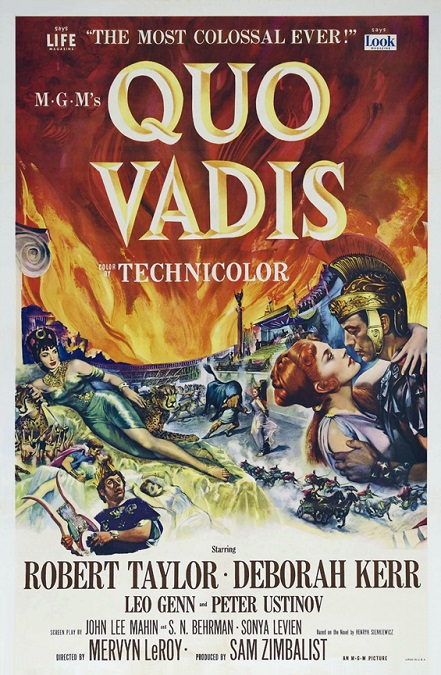
Quo Vadis – 1951
Quo Vadis was a gigantic, three hour spectacle, a feast for the senses, a production on a massive scale. It was a big MGM blockbuster on par with Ben-Hur, except that… it came first. Ben-Hur would not be hitting the screen for another eight years. In fact, it is doubtful that Ben-Hur would ever have been made if Quo Vadis had not been as big a hit as it was.
True, it was not, by any means, the first biblical epic ever made. In fact, it was not the first time Quo Vadis had been made. It had first been made as a silent film in 1901, a second time in 1912, a third time in 1924, and finally, a fourth time, in 1951. Incidentally, it was also made a fifth time in 2001, and as a 6 hour miniseries in 1985. Obviously, it is a popular story.
But what made the 1951 version stand out enough to be nominated for Best Picture? This was the first sound version of the film ever made, and it was in glorious Technicolor, something of which it took full advantage. Director Mervyn LeRoy and producer Sam Zimbalist took on the massive project that was nominated for a total of 8 Academy Awards, though amazingly enough, it didn’t win a single one.
Quo Vadis, which is a Latin phrase meaning, “Where are you going?” is about a Roman Commander, Marcus Vinicius, played by Robert Taylor. He is, of course, a heathen, a stereotypical example of a pompous, pig-headed legionnaire and soldier. He returns to Rome after a 3 year campaign of war and slaughter. He sees a beautiful girl who was once a slave, but has become the adopted daughter of an old friend. She is Lygia, played by the beautiful Deborah Kerr. He desires her and is willing to do anything to get her. So he goes to his uncle, Petronius, wonderfully played by Leo Genn, who is one of Emperor Nero’s advisors. Nero was wonderfully played by Peter Ustinov. As a gift to his favored Commander, Marcus, Nero gives him Lygia by royal order.
The performances of all the actors were good, but I would have to call those of Genn and Ustinov inspired. Ustinov’s childish and blithely cruel Nero was one of the best parts of a good film. He was so appropriately bonkers. And Genn’s portrayal of Nero’s trusted advisor who secretly despised him was perfectly executed. At first, I thought his character was one of the bad guys, but I eventually learned that he, while not one of the good guys, was at least an honorable character.
The huge and epic nature of the film was, from what I have read, historically accurate, especially the sets and costumes. Apparently the original author of the 1896 novel, Henryk Sienkiewicz, had actually traveled to the historical sites in Italy, saw and studied the ancient ruins, and learned about the ancient Roman customs and culture. However, the focus of the novel was actually on the character of Saint Peter, played in the film by Finlay Currie, and his vision of Christ as he is fleeing Rome. This does happen in the film, but it is only a sub-plot next to the romance between Lygia and Marcus, and Marcus’ conversion to Christianity.
The film got so many things right, but I have to mention a few minor things that I think they got wrong. I realize that I am being incredibly nit-picky, but if I wasn’t I wouldn’t have any criticisms at all. For example, when a woman is speaking in a gigantic coliseum, it would be difficult to hear her from too far away. But don’t worry. This woman was obviously using a microphone. But the one thing that really stuck in my craw was the depiction of the Last Supper. As Peter is describing the famous meal, we see his memory of the scene, showing that he was actually there. But then we are shown a live recreation of the Leonardo Da Vinci painting. Why?!? It is an artist’s famous representation of the event, painted 1500 years after the story of Quo Vadis takes place!
But Nero’s burning of Rome was a particularly exciting scene to watch and was well done. The large, screaming mobs and the crumbling buildings were great. Just watch out for the blue-screening. It was awesome that they had such technology at their disposal, but it didn’t really hold up to my modern eyes. The bright purple lines around the figures really stood out like sore thumbs. But I’m not complaining. It was still a great movie that took a lot of risks and competently paved the way for other great biblical epics like Ben-Hur, The Ten Commandments, and King of Kings. And thank goodness it was in Technicolor. It wouldn’t have been nearly as exciting to watch in black and white.
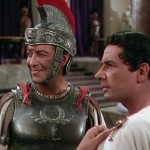
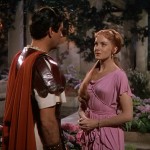
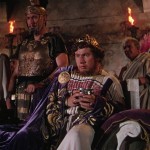
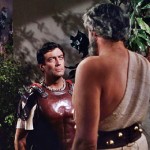





Found your comments very accurate but missing the bright purple lines. Must see it again. Saw it first as a teenager. Then I read the book which was fabulous. Now having seen it as a dowager on TV. And the music was what caught my ear and spirit. Was so glad to be able to receive some good information on the music and all the rest. Thank you.